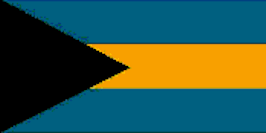The Bahamas - People
 According to a 2010 census, The Bahamas had a population of 353,000, but current estimates indicate these figures have increased by 15 percent to approximately 406,000. The U.S. government estimated the total population at 325,000 (July 2015 estimate). Some 70 percent of the population (approximately 285,000) resides on the island of New Providence – where the capital, Nassau, is situated. Another 15 percent live on Grand Bahama, which has the country’s second largest city, Freeport. The rest of the population is dispersed over two dozen outer islands (commonly referred to as the “Family Islands”).
According to a 2010 census, The Bahamas had a population of 353,000, but current estimates indicate these figures have increased by 15 percent to approximately 406,000. The U.S. government estimated the total population at 325,000 (July 2015 estimate). Some 70 percent of the population (approximately 285,000) resides on the island of New Providence – where the capital, Nassau, is situated. Another 15 percent live on Grand Bahama, which has the country’s second largest city, Freeport. The rest of the population is dispersed over two dozen outer islands (commonly referred to as the “Family Islands”).
According to the 2010 census, more than 90 percent of the population professes a religion. Protestants make up 72 percent of the population and include Baptists (35 percent of the population), Anglicans/Episcopalians (15 percent), Pentecostals (8 percent), Church of God (5 percent), Seventh-day Adventists (5 percent), and Methodists (4 percent). Roman Catholics make up 14 percent of the population. Smaller religious communities include Greek Orthodox Christians, Jews, Bahais, Jehovah’s Witnesses, Rastafarians, Muslims, and The Church of Jesus Christ of Latter-day Saints (Mormons). A small number of Bahamians and resident Haitians, particularly those living in the Family Islands, practice Obeah, which is similar to Voodoo. Some members of the small resident Guyanese and Indian populations practice Hinduism.
Rastafarian leaders reported their members continued to experience police profiling and targeting due to their belief in the religious use of marijuana. They also expressed concern that prison officials cut the dreadlocks of Rastafarian detainees held in short-term custody, and that prisoners at Bahamas Correctional Services were not regularly provided with meals that met their religious dietary requirements. There were no arrests related to violations of the law against practicing Obeah. The law prohibiting blasphemy was not enforced.
Eighty-five percent of the Bahamian population is of African heritage. Many ancestors arrived in The Bahamas when the islands served as a staging area for the slave trade in the early 1800s. Others accompanied thousands of British loyalists who fled the American colonies during the Revolutionary War. The population of the Bahamas tripled when thousands of black and white Loyalists arrived from Charleston, Savannah, and British East Florida.
The majority of the black evacuees were natives of the Gullah or “Geechee” cultural regions of the coastal Carolinas and Georgia. Culturally and linguistically, the character and personality of the Bahamian people owe much to the Gullah people who live in the coastal islands offshore of South Carolina and Georgia.
The majority of Bahamians today trace back their roots to the thousands of West Africans who were enslaved and brought to the islands in order to work on cotton plantations by those loyal to the British Crown. Britain abolished its slave trade in 1807, and resettled thousands of liberated Africans from foreign slave ships as free persons in the Bahamas. In the early 1820s, hundreds of American slaves and Black Seminoles escaped from Florida, with many of them settling on Andros Island in the Bahamas. Britain officially abolished slavery throughout most of the British Empire in 1834, thereby ending plantation life in the Bahamas and giving rise to a nation of seafarers.
Haitians form the largest immigrant community in The Bahamas. 30,000-60,000 are estimated to be resident legally or illegally, concentrated on New Providence, Abaco, and Eleuthera islands.
The country’s racial and ethnic groups generally coexisted peacefully, but anti-Haitian prejudice and resentment regarding Haitian immigration was widespread. According to unofficial 2016 estimates, between 40,000 and 80,000 residents were Haitians or persons of Haitian descent, making them the largest ethnic minority. Many persons of Haitian origin lived in shantytowns with limited sewage and garbage services, law enforcement, or other infrastructure. For example, a number of shantytowns on New Providence and other islands consisted of houses built from trash and discarded building materials, with few organizational, infrastructure, or sanitation measures in place.
The government occasionally evicted residents and demolished some settlements due to health and safety concerns. Fires frequently broke out in Haitian shantytowns in Nassau, at least some of which were deliberately set, according to human rights organizations. Authorities generally granted Haitian children access to education and social services, but interethnic tensions and inequities persisted. Haitians generally had difficulty in securing citizenship, residence, or work permits.
In 2014 the government began conducting large-scale immigration raids in Haitian neighborhoods and increased deportations of Haitian immigrants. Members of the community, as well as human rights NGOs, argued that the raids were conducted without probable cause and were marked by verbal and physical abuse. An elderly, bedridden woman claimed that immigration officers stomped and kicked her in October, hospitalizing her for 15 days and rendering her permanently unable to walk. Witnesses also claimed that warrantless searches of homes were common during these raids.
School attendance is compulsory between the ages of 5 and 16. The government fully operates 157 of the 252 primary and secondary schools in The Bahamas. The other 95 schools are privately operated. Enrollment for state primary and secondary schools is 48,545, with more than 21,000 students attending private schools. The College of The Bahamas, established in Nassau in 1974, provides programs leading to bachelors and associates degrees. Several non-Bahamian colleges also offer higher education programs in The Bahamas.

|
NEWSLETTER
|
| Join the GlobalSecurity.org mailing list |
|
|
|

